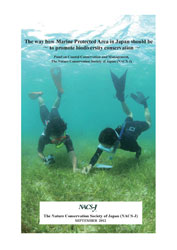The way how Marine Protected Area in Japan should be ~ to promote biodiversity conservation ~
The way how Marine Protected Area in Japan should be~ to promote biodiversity conservation ~(PDF/English/1.8MB)
Introduction – Why is the MPA discussion important in Japan ?
The discussion on Marine Protected Area (MPA) has recently drawn growing attention worldwide. Behind this development is, “Target 11” of the “Aichi Targets” (Strategic Plan 2011-2020), adopted in 2010 by the 10th Conference of the Parties of the UN Conservation on Biodiversity (CBD-COP10). This COP took place in Aichi, and thus Japan chaired the meeting. Target 11 states, “By 2020, at least 17 per cent of terrestrial and inland water areas and 10 per cent of coastal and marine areas, especially areas of particular importance for biodiversity and ecosystem services, are conserved through effectively and equitably managed, ecologically representative and well-connected systems of protected areas and other effective area-based conservation measures, and integrated into the wider landscape and seascape.”
In response to this, the Japanese government announced that “8.3 % of Japan’s marine areas are designated as MPAs” (Headquarters for Ocean Policy 2011). Yet, many issues remain as to whether the area the government is calling MPA truly functions to conserve biodiversity and the natural ecosystem and allow sustainable marine resource uses. The Nature Conservation Society of Japan (NACS-J) set up a Panel on Coastal Conservation and Management to discuss these issues. As a result, two proposals were drawn up, Proposal 1 on reconstructing the MPA system and, as a result of an examination of necessary conditions for MPAs, Proposal 2 on prerequisites for MPA designation that would be desirable in future.
NACS-J strongly hopes that these proposals will result in the designation of more effective MPAs, which are fundamental to ensure the conservation and sustainable use of biodiversity.



